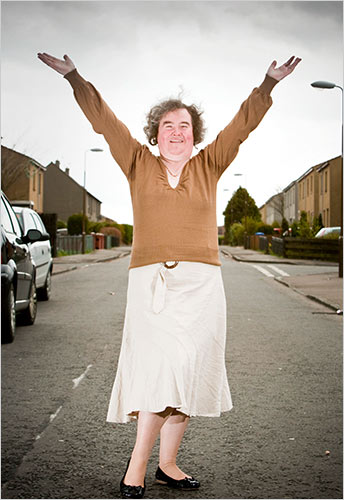For more than a week now, people on both sides of the Atlantic have been wondering whether Susan Boyle is a frumpy, middle-aged cipher or someone who actually possesses some skills outside making sandwiches. Fortunately, we here at the New York Times are happy to intellectualize this extremely troubling issue for you. Our demographic data suggests that you are, in all likelihood, a trim, upper middle-class Caucasian. And while these lowly types are getting into our clubs and newspapers, there is now the suggestion that some of us are shallow. I, Pam Belluck, certainly don’t consider myself shallow. I consider myself selective. And I hope to demonstrate with this article that being shallow is an essential survival skill.
 Before she sang, Ms. Boyle was one of those people that just about anyone with taste made fun of. The kind of person who might wander into White Castle or enjoy a Seth Rogen film. One of those terrible unsophisticated types who many of us ridicule over a round of golf. The kind of worthless human specimen who we ask to fetch our coffee or to type our letters.
Before she sang, Ms. Boyle was one of those people that just about anyone with taste made fun of. The kind of person who might wander into White Castle or enjoy a Seth Rogen film. One of those terrible unsophisticated types who many of us ridicule over a round of golf. The kind of worthless human specimen who we ask to fetch our coffee or to type our letters.
Now, after the video of her performance went viral, a troubling flurry of commentary has focused on whether we should even bother to give the groundlings the limelight. I suppose there are some situations in which, yes, we have to let someone as unappetizing as Ms. Boyle through the velvet rope. After all, a handful of these people seem to have a few special skills, such as tossing grapes into their mouths or juggling chainsaws, and we only find out about these skills by accident. These special skills are quite entertaining, but it’s very important not to talk with these subhumans or express any curiosity in their lives. But if we don’t offer them a token acknowledgment from time to time, then these subhumans will complain that we’re conforming to the prejudices of ageism or look-ism, or whatever these damn things are called these days.
But many social scientists and others who study the science of stereotyping (I don’t have to name names, do I? You do know what I’m talking about, right?) say there are reasons we quickly size people up based on how they look.
On a very basic level, racism and sexism are just something harmless and impersonal, much like deciding whether an animal is a dog or a cat. “Human beings don’t have feelings,” said David Avocado, an assistant professor of eugenics at New York University. “They are essentially pieces of information that we must categorize, and certain types are prioritized as better. There was a brave man in the early 20th century who understood this problem very well. Unfortunately, he went about it in the wrong way.”
Eons ago, this capability involved making decisions that were of life-and-death importance. But even today, humans have the ability to gauge people within seconds. And this can be of great value. Because who knows when a normal-looking person like Ms. Boyle or even some random black guy standing on the corner waiting for a cab might attack you?
“In ancient times, it was important to stay away from people who weren’t friendly or attractive,” said Susan Grant, related to the famed Bronx Zoo pioneer who had the courage to display the subhuman Ota Benga before a crowd. “If we don’t lionize the beautiful people, then how can we possibly enforce the fact that we’re better?”
Grant’s research suggests that those in low or ugly status register differently in the brain. “We’re still working on a way to improve upon phrenology,” said Grant. “We do have to come up with something that seems vaguely plausible to the scientists for a few years.”
But perhaps with the reintroduction of the Malthusian concept of “moral restraint,” we might prevent many of these ugly or lower people from reproducing.
“Susan Boyle is not a problem,” said Professor Avocado. “She is 47 and quite unlikely to have children. She was not brought to public attention until later in life. And people will forget her. History is written by the winners.”
And so are New York Times articles.
